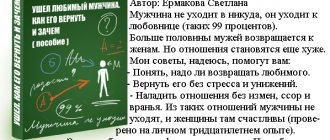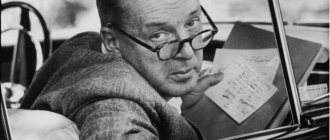Category: Professions
975
Article rating: 4
Sigmund Freud is a famous psychiatrist, psychologist, psychoanalyst, founder of psychoanalysis.
Born on May 6, 1856 in Freiberg (Austria). Even as a child, Freud developed a love for literature, and then for philosophy. At the age of 17 he graduated from high school with honors, and in 1873 he entered the University of Vienna. In 1881, Sigmund opened his office to treat people for psychoneuroses.
The basis of Freudian psychoanalysis is the following: the patient is unable to control the thoughts in his head and voices the first thing that comes to his mind using his dreams, imagination and associations. He believed that the cause of neuroses is a chain of conscious and unconscious processes that are in constant interaction.
His method of treating mental disorders made major contributions to medicine, psychiatry and psychology.
In 1899, Sigmund Freud's book The Interpretation of Dreams was published. In this book, he applied the methods of psychoanalysis in the interpretation of dreams. He believed that dreams are a kind of cipher or code through which hidden desires find a way out.
Already in 1900, his next work, “The Psychopathology of Everyday Life,” was published. In this book, he showed that various slips, mistakes, and substitutions of words are not an accident, but a consequence of the suppression of thought in attempts to hide it in the unconscious.
Based on his writings, Sigmund Freud created the “Introduction to Psychoanalysis” lectures, which are still used today, despite the fact that they are subject to constant criticism.
Sigmund Freud (1856-1939)
Austrian psychologist, neurologist, psychiatrist. Creator of the theory of psychoanalysis. He was the first to develop a substantiated three-component theory of personality, define the stages of human psychosexual development, describe many mechanisms of psychological defense, and develop psychotherapeutic methods for interpreting dreams and free associations.
The author of numerous scientific works, Freud had a tremendous influence on medicine, sociology, anthropology, art and literature of the twentieth century, his theories were a breakthrough in psychology and psychiatry, and his treatment methods were far ahead of their time and remain in demand to this day.
Vladimir Lvovich Levi
In 1938, a son was born into a family of engineers (father a metallurgist, mother a chemist), who was destined to break the emerging dynasty and become a luminary of medical science - as well as a member of the Writers' Union!
Vladimir Lvovich Levi worked as a psychiatrist at the Kashchenko Hospital; Researcher at the Institute of Psychiatry. Among other things, he made an important contribution to the creation of a “helpline”.
He attaches great importance to the popularization of scientific knowledge and the dissemination of advanced ideas. Back in 1967, his debut work “The Hunt for Thought: Notes of a Psychiatrist” became widely known.
In total, Vladimir Lvovich published more than 30 popular science works. But his writing talent was not limited to prose - he wrote (and continues to write) poetry. In 2000, his poetry was published in the collection Crossed Out Profile.
Carl Gustav Jung (1875-1961)
Swiss philosopher and psychiatrist, founder of one of the currents of depth psychology, namely analytical. In working with the unconscious, he tried not only to solve the problem of childhood fears, but also to explore the memory of generations, drawing parallels between mysticism, alchemy and psychology. The main theme of his works was the relationship between thinking and culture, biological and cultural-historical factors in the development of peoples, the difference in the worldview of the East and the West, the analysis of myths, tales and legends. He considered the combination of the conscious and unconscious to be the source of culture.
He developed the theory of the collective unconscious, worked using the method of free associations and interpretation of archetypal symbols and images. He introduced the terms “introversion” and “extroversion”, a typology of characters, and considered the main task of psychotherapy to be assistance in realizing the individuality of each person.
Hakob Pogosovich Nazaretyan
The merits of this scientist in the field of psychology of mass behavior and in the field of cultural anthropology cannot be overestimated. Hakob Nazaretyan is a native of Baku. The scientist was born in 1948. Over the years of service to science, he wrote a huge number of monographs, where he explored the problems of the theory of social development.
In addition, Akop Pogosovich became the author of the assumption that there is a techno-humanitarian balance in the world, which is in close relationship with technical progress and culture.
Abraham Maslow (1908-1970)
American psychologist, founder of the direction of humanistic psychology. Personality theories built on the basis of psychoanalysis, data for which were usually collected when diagnosing people with certain disorders or deviations, were contrasted with the personality theory of a healthy, realized person.
Maslow's most famous theory is the theory of motivation, from which he derived the hierarchy of needs, better known as Maslow's pyramid; put the human need for self-realization at the forefront.
Albert Bandura
Albert Bandura is an American psychologist known for creating social learning theory and the Bobo Doll experiment.
Born on December 4, 1925 in a small village in northern Canada. After graduating from high school, Bandura worked on highway restoration in the state of Alaska. He graduated from the University of British Columbia in 1959, and in 1952 he received a PhD in clinical psychology and began teaching at Stanford University.
Social Learning Theory, written by Albert Bandura, shows the constant interconnection of cognition, behavior and environment. This theory emphasizes the importance of learning through imitation and observation.
The Bobo Doll experiment was conducted in 1961. A group of children were shown a videotape of a woman hitting a Bobo doll and yelling at it aggressively. The children were then allowed to play in the room where the Bobo doll was located. They began to beat this doll and imitate the movements and words of the woman from the video. The experiment showed that the children, without receiving any reinforcement or incentive, simply repeated the behavior that was observed on the video recording. This allowed us to move a little away from behaviorist ideas. Based on his observations and experiments, Bandura wrote the book “Teenage Aggression,” which was translated into Russian.
Albert Bandura's theories made a great contribution to the development of personality psychology and psychotherapy, and he truly can be called the greatest psychologist of our time.
Dale Carnegie (1888-1955)
American educator, psychologist and writer. He was at the origins of the theory of communication, but placed the main emphasis on the practical application of scientific developments, created his own concept of successful communication and a unique system for teaching communication skills. He wrote several books on practical psychology, which remain in demand to this day. The most famous of them is “How to Win Friends and Influence People” (1936). The book was a bestseller for 10 years, which was an absolute record.
Based on personal developments, he created the Institute of Human Relations and Oratory.
Kurt Lewin
Kurt Lewin is a German psychologist and sociologist. Founder of social psychology who pioneered the study of organizational development and group dynamics.
Born on September 9, 1890 in the German city of Mogilno. Since 1910, Levin studied at the University of Berlin. He took part in the First World War, but was demobilized due to injury. At the front, Kurt was also engaged in scientific activities, observing his fellow soldiers and conducting surveys. The main conclusion that the scientist made: soldiers perceive the situation at the front differently than civilians, and a change in perception occurs not only in one soldier, but in a whole group of front-line soldiers.
After returning from the front, Kurt Lewin continued his studies at the University of Berlin. In 1936, he emigrated to the United States and became head of the Group Dynamics Research Center at the Massachusetts Institute of Technology.
In the United States, Lewin became the first expert on group behavior. In the first half of the 20th century, Kurt Lewin developed Psychological Field Theory. In his theory, he proceeded from the fact that each personality develops in the psychological field of objects surrounding him, which have their own charge. The scientist's observations and experiments showed that for each individual this charge has its own sign. But at the same time, there are objects that have both attractive and repulsive forces for a person. This force causes needs in a person and tension in him. And, being in a state of tension, a person tries to discharge, i.e. satisfy your needs.
Based on the problems of field theory, Kurt Lewin wrote the book “Field Theory in the Social Sciences.” And the book “Resolution of Social Conflicts” contains practical and theoretical research by the scientist on the problems of mass consciousness, interpersonal conflicts, ethnic problems, etc.
Irvin Yalom (born 1931)
Contemporary American psychologist and psychotherapist. Representative of existential psychology (one of the areas of humanistic psychology). The methodology of his work is largely based on psychoanalysis, but Yalom has always been opposed to “therapy for everyone”, based on formal diagnoses, without taking into account the individuality of the patient. He believes that for each person with his unique history and problems, a new therapy should be developed, built on an interpersonal relationship between the patient and the doctor, mutually open and frank.
Particular attention is paid to the issue of overcoming the existential fear of death.
Bluma Vulfovna Zeigarnik
This is also a world-famous scientist. The famous female psychologist Bluma Vulfovna Zeigarnik was born in 1900 in the Lithuanian town of Preny. She studied with such eminent psychology specialists as K. Levin, E. Spranger, K. Goldstein. Zeigarnik shared the scientific views expressed in Gestalt psychology. Opponents of this theory repeatedly tried to dissuade Bluma Vulfovna from attending Levin’s classes, but she remained adamant. The woman became famous for identifying a unique pattern, which later became known as the “Zeigarnik effect.”
Its meaning is simple. A female psychologist performed a simple experiment. She gathered a certain number of people and asked them to solve a particular problem within a specific period of time. As a result of the experiments, Bluma Vulfovna came to the conclusion that a person remembers unfinished actions much better than completed ones.
Karen Horney (1885-1952)
American psychoanalyst, psychologist. Representative of the neo-Freudian movement. She studied the impact of the cultural environment on human neurotic behavior. According to her beliefs, the cause of any neurosis is the social environment and disturbances in human relationships. Classical psychoanalysis believes that the causes of neuroses are genetic and instinctive.
Horney believed that the goal of therapy was to restore normal relationships between people, which would allow them to get rid of neurotic patterns and find support within themselves.
Alois Alzheimer
The term “Alzheimer’s disease” is probably on everyone’s lips. The name of the famous neurologist and psychiatrist, born in 1864 in Germany, is immortalized in a dozen other symptoms and pathologies of the nervous system. But this is his celebrity “for the general public.”
Alois Alzheimer was engaged in research and scientific activities all his life. Numerous scientific publications were combined by him into the fundamental multi-volume book “Histological and histopathological studies of the gray matter of the brain .
But a significant part of creativity remains accessible only to the mind of a specialist in the form of publications in specialized literature.
Hermann Rorschach (1884-1922)
Swiss psychologist, psychiatrist, author of the Rorschach Blot personality test.
A talented artist, Rorschach nevertheless chose medicine as his profession, namely psychiatry. He studied hallucinations and related phenomena, psychoanalysis, which ultimately led to the emergence of the theory of psychodiagnostics. In 1921, the famous test with tables in the form of inkblots was published.
Rorschach considered psychodiagnostics the key to understanding both the personality and its capabilities, and seriously worked towards the unification of such sciences as history, religion, psychopathology and sociology. But his early death did not allow him to complete a number of scientific developments he had begun.
Melanie Klein
In the “Famous Child Psychologist” category, her person ranks far from last. Melanie Klein was born in 1882 in the Austrian capital. She always recalled with nostalgia her childhood years, which were filled with happiness and joy. Melanie's interest in the science of the soul awoke after she experienced psychoanalysis twice.
Subsequently, Klein would write valuable scientific monographs on aspects of child psychoanalysis. And despite the fact that Melanie’s theory will run counter to the Freudian doctrine of child analysis, she will be able to prove that a simple child’s game can reveal many secrets of the child’s psyche.
Eric Berne (1910-1970)
American psychologist and psychiatrist. Author of transactional and scenario analyses. Based on the classical theory of psychoanalysis, Berne focused on actions that become the basis for interpersonal relationships. In addition to obvious and open motivations, he distinguished the so-called games played by three human ego states: Adult, Parent and Child.
All three states are formed in childhood, in the process of communication between the child and parents, who provide him with images, examples, samples and anti-models of behavior.
Victor Ivanovich Ovcharenko
This outstanding scientist was born in 1943 in the city of Melekess (Ulyanovsk region). His achievements in psychology are incredibly enormous. Thanks to his research, the science of the soul has significantly advanced in its development. Viktor Ivanovich wrote more than one work of fundamental importance. The scientist analyzed sociological psychologism and deeply studied issues of interpersonal relationships.
His monographs were published not only in Russian but also in foreign media.
In 1996, Ovcharenko came up with the idea of rethinking the historical periods of domestic psychoanalysis before the scientific community. He initiated the publication of publications in which he reflected the biographies of about 700 eminent people, including psychologists, philosophers, and cultural experts.
Lev Semenovich Vygotsky (1896-1934)
Famous Soviet psychologist, founder of the cultural-historical concept of the development of higher mental functions of a person, author of many literary publications and works on pedology and cognitive development of the child.
He distinguished between lower and higher mental functions, the former believed to be the result of biological evolution, the latter - the result of the historical development of society.
In the last years of his life, he paid a lot of attention to the study of the relationship between thought and speech; instead of the dyad consciousness - behavior, he proposed the triad consciousness - culture - behavior, becoming the founder of domestic psycholinguistics.
Jean Piaget
Jean Piaget is a psychologist who wrote many works on child psychology and created the theory of cognitive development. He is the founder of the Geneva School of Genetic Psychology.
Born on August 9, 1896 in Neuchâtel (Switzerland). His scientific career began in childhood. Then he began to become interested in biology and had already written several works on malacology (the study of mollusks). By the age of 20, he had defended his dissertation in the natural sciences and received a PhD from the University of Neuchâtel. At this time he began to become interested in psychoanalysis.
After receiving his degree, Piaget moved to Paris and began teaching at one of the schools whose director was A. Binet, who created the IQ test. Piaget helped process the test results and noticed one strange pattern: children always answered certain questions incorrectly. They made the same mistakes, which are usually not typical for adults. Based on these observations, Piaget wrote a paper called Developmental Stage Theory, which argued that people at the same stage of development exhibit similar forms of cognitive ability. That is, he made a discovery: children are not dumber than adults, they just think differently.
According to Piaget's theory, human intelligence goes through several stages during development:
- Sensorimotor stage (0-2 years) - babies gain knowledge through sensory experience and are limited by innate reflexes;
- Pre-operational stage (2-7 years) - children learn about the world through play, which hides the complex process of developing logic and perceiving the point of view of other people;
- Stage of concrete operations (7-11 years) - children have good logic, but do not have the flexibility of thinking that is characteristic of an adult. At this stage, children have difficulty understanding abstract and hypothetical concepts;
- The Formal Operations Stage (ages 11-15) is the stage in which logic, deductive abilities, and the ability to accept and understand abstract ideas develop.
Piaget translated his knowledge of developmental theory into the book “Speech and Thinking of the Child.” In this book he studied egocentrism, juxtaposition, and the logic of relationships. The world psychology of children's thinking is based on the works of Jean Piaget. And the book “Psychology of Intelligence” covered more than half of the entire subject of psychology.
Erich Fromm (1900-1980)
German sociologist, philosopher, social psychologist, psychoanalyst. He highly valued classical psychoanalysis, but argued that it does not answer the question of how to live and what to do. He proposed considering psychoanalysis as one of the natural sciences, and he himself tried to shift the emphasis from biological motives of behavior to social factors, including ethics in the range of issues to be considered.
Fromm believed that the main moral problem of the modern world is man’s indifference to himself. And the main task of humanistic psychoanalysis is a person’s knowledge of the truth about himself, the determination of psychological guidelines, the awareness of moral problems as fundamental, because man is the only creature with a conscience.
Fromm's works are devoted to the philosophical, ethical and socio-psychological aspects of human nature, the question of his place in the world and the meaning of existence.
Share link
Ivan Pavlov
Ivan Pavlov is a Soviet scientist, physiologist, whose research influenced the development of psychology and behaviorism.
Born on September 14, 1849 in a small village in Ryazan. Even in his early years he became interested in reading Darwin's works on the origin of species, and in 1870 he devoted himself to the study of natural sciences at St. Petersburg University.
Ivan Pavlov's main interest was the study of physiology. He studied digestive function in dogs and noticed that the animals salivated just before food was served. Pavlov conducted an experiment. The dog underwent surgery to remove the salivary glands to accurately record the onset of salivation. Food was served to the dog immediately after the metronome beats. Soon the scientist observed a conditioned reflex: after several repetitions of the metronome beats and serving food, the dog salivated only at the sound of the metronome. Pavlov established that conditioned reflexes originate in the cerebral cortex.
Ivan Pavlov received great recognition for his work. In 1901 he was accepted into the Russian Academy of Sciences, and in 1904 the scientist received the Nobel Prize in Physiology.
I. Pavlov’s greatest work was the book “Conditioned Reflexes,” published in 1923. The book “Reflex of Freedom” was also published, which collected lectures, articles and speeches by Ivan Petrovich Pavlov. The book also includes little-known works of the scientist that were not published during his lifetime.
"I'm not rich, but I'm working on it"
All this made Mikhail Labkovsky not only the most popular psychologist in Russia, but also a successful entrepreneur. He estimates his total income at 130 million rubles a year (Labkovsky works as an individual entrepreneur). “I definitely can’t call myself rich. But I'm working on it. Because I want to live and not count money in my pocket. It's an incomparable pleasure when you don't even ask how much it costs. Moreover, I'm afraid to ask. I’m afraid that if I start counting money, I might slide into poverty out of fear,” Mikhail is frank.
The main source of his income is public consultations. Each one attracts from 400 to 1500 people, tickets cost 1500-5000 rubles. Average revenue ranges from 1.5 million to 3 million rubles per lecture. The number varies from month to month: in a tour organized in advance, performances can take place every day, and in the summer Labkovsky takes vacations for himself. “I have no boundaries between rest and work: even when I go on vacation, I organize lectures along the way and earn money,” he says. “Most people, especially rich people, work hard, get drunk on Friday, and on New Year’s Eve go to the Maldives for two weeks. That’s why businesses are most often run by neurotics.”
Advertising on Forbes
In 2022, public consultations brought him about 90 million rubles in revenue and about 70 million rubles in net profit (after deducting the costs of renting a hall, paying organizers and taxes), says the psychologist. The most popular among the lectures remains “How to Get Married” - Labkovsky read it in Moscow for 12 months in a row to invariably full halls.
Sales of the book over two years brought in another 40 million rubles in profit; by the end of 2022, this amount should reach 70 million rubles, Mikhail predicts.
Labkovsky continues to give private consultations. Despite the impressive price - 95,000 rubles for a personal 45-minute meeting and 140,000 rubles for a Skype conversation - they bring no more than 10-12 million rubles per year, since they happen quite rarely. According to Amina Nazaralieva, these prices are tens of times higher than the market average: in Moscow, the average cost of a consultation with a qualified psychologist is 5,000 rubles, a session in expensive clinics is a maximum of €300. “Why do people choose Labkovsky? They probably trust his publicity. And they are also afraid of losing anonymity by turning to a psychotherapist in a clinic where they require passport information. This may be especially true for public figures and family members of officials,” she said.
According to Labkovsky himself, one or two sessions are enough for clients to deal with an exciting problem. “If you come to the doctor with a temperature of 39, he gives you a pill and it works, then he is a good doctor. What if after taking the pill the temperature rises to 39.5? Why the hell should I go to this doctor again? “Are you morons, or what?” Labkovsky jokes. At the same time, he denies the title of exclusively “Rublevsky psychologist”: among the clients are not only wealthy people, but also teachers and doctors, Mikhail assures. “They have this money, I’m talking about Muscovites now. The question here is about setting priorities, about what is considered a value.”
Photo by Oleg Yakovlev
Screen Analyst
In Moscow in the late 90s, Mikhail Labkovsky first went into business. He gave private consultations and charged $50 an hour—five times more than they paid in Israel. To increase the flow of clients, Labkovsky decided to enter the media field: he called several radio stations and agreed on an author’s program on Radio Nadezhda. “It was a wild market in the 90s: instead of advertising, a guy usually came in a truck and sold Lyubertsy carpets to people live. And I’m here with psychology,” recalls Mikhail. Heart-to-heart conversations were new to Russian listeners, and programs with Labkovsky aroused interest. But television brought real fame to the psychologist.
Labkovsky was brought to the silver screen by his own aunt, who worked in the state historical archive of the USSR. Through her colleagues, she helped Mikhail get on the Russia-1 channel. Labkovsky “learned by doing” and soon became the author and director of the day program “Family Hearth”. “Well, what do they show there during the day - fashion, home, renovation, all sorts of bullshit and a ton of psychology,” Labkovsky describes his first TV experience.
After this program, the young charismatic psychologist went “on television”: as an expert, he participated in the scandalous program “About This” and “The Domino Principle” on NTV, in “My Family” by Valery Komissarov, and nightly broadcasts on radio “Echo of Moscow”. “I promoted psychology for everyone - so that a person, when he feels bad, does not go to drink or hang himself, but turns to a psychologist or psychiatrist. It was a kind of revolution - there was no psychological culture in the country at that time,” states Labkovsky.
Photo by Oleg Yakovlev
The surge of mass interest in psychology in Russia arose precisely thanks to Labkovsky, confirms Amina Nazaralieva, psychotherapist, co-founder of the Mental Health Center. “The ground for it was prepared by Andrei Kurpatov, who also started performing on television, but professionals treat him with even greater skepticism,” says Nazaralieva. “Labkovsky hit the mark with his simple truths about self-love.” The main component of the success of “telepsychology” lies in the fact that such programs deal with universal human topics: jealousy, sex, raising children, infidelity, self-esteem, relationships with parents, adds Ilya Shabshin, psychologist, specialist at the Psychological Center on Volkhonka. “Moreover, simple solutions and answers are offered. There is no deepening into details and nuances, as is done during psychological counseling and psychotherapy. Often instructions and advice are given - which should not happen during a consultation: a professional psychologist does not give advice,” he believes. According to Amina Nazaralieva, the history of Russian society also played a role, in which for many years violence and suppression of the individual were the norm: “There was no official sex in the Soviet Union, it was not customary to talk about relationships and experiences. And any significant part of a person’s life, which has been kept silent for a long time, will arouse interest.”
Thanks to popularity on TV and radio, the price for a private consultation with Labkovsky reached $200. But the media activity itself did not generate income. “That’s why our television is so crappy that no one pays guests on programs. It is believed that the guest needs this, this is his advertising. I fundamentally disagree with this - there are no guests on television, this is work that must be paid,” says Mikhail.
Sometimes such adherence to principles backfired on Labkovsky. The psychologist recalls how in the early 2000s, Elena Malysheva (author of the “Health” and “Live Healthy!” programs on Channel One) offered him the role of presenter in a program about psychology called “The Naked Truth.” After filming two programs, Mikhail raised the issue of payment. He was no longer invited to filming. Channel One, 26 minutes of fame every week. Millions passed by. This is not just free advertising, it would be a completely different life.”
Courses by psychologist Mark Barton
You can listen to the coach's lectures on YouTube. Read more detailed information, order a consultation or buy a book on your personal blog mark-barton.com. The site presents Barton courses on a variety of topics:
- self-development;
- fear and phobias;
- parenting;
- emotions and feelings;
- sex, etc.
There is also a schedule of all events that are held online. His most famous course, “I am a Woman,” became the flagship product of this project. It is female spectators who make up Mark Barton's main audience. Being a mature man and an experienced family specialist, he gives very useful advice on how a woman can gain her own self-worth, attract a worthy man and build harmonious relationships.
Adler Alfred
First of all, Alfred Adler (born in 1870 in Austria) is known as the founder of “individual psychology.”
Having at first been an ardent admirer and supporter of Sigmund Freud, in 1907 Adler managed to quarrel with the recognized maestro of psychology.
In his book “A Study of Organ Inferiority,” Adler convincingly defended his views that the psyche is determined not only by childhood sexuality, but should be studied in conjunction with present circumstances.
“On Nervous Character,” published in 1912, fully reveals the foundations of what was later called “individual psychology.” His further works only more fully reveal these views and are aimed at their popularization among the masses.
Translations of the works “The Science of Living” are quite accessible to the domestic reader; “Individual psychology as a path to human knowledge and self-knowledge”; "Treatment technique" .











